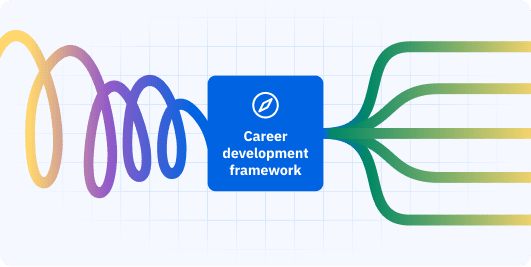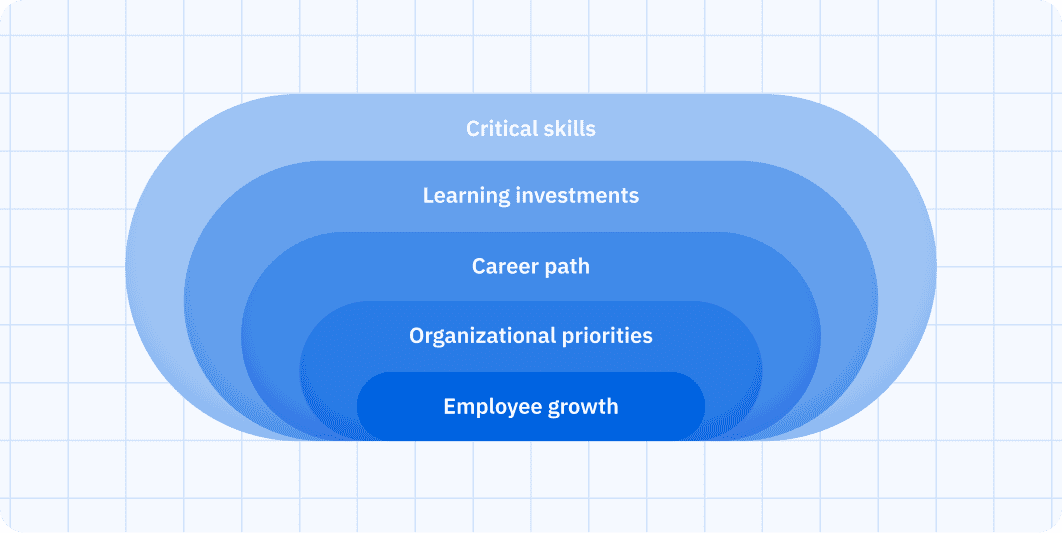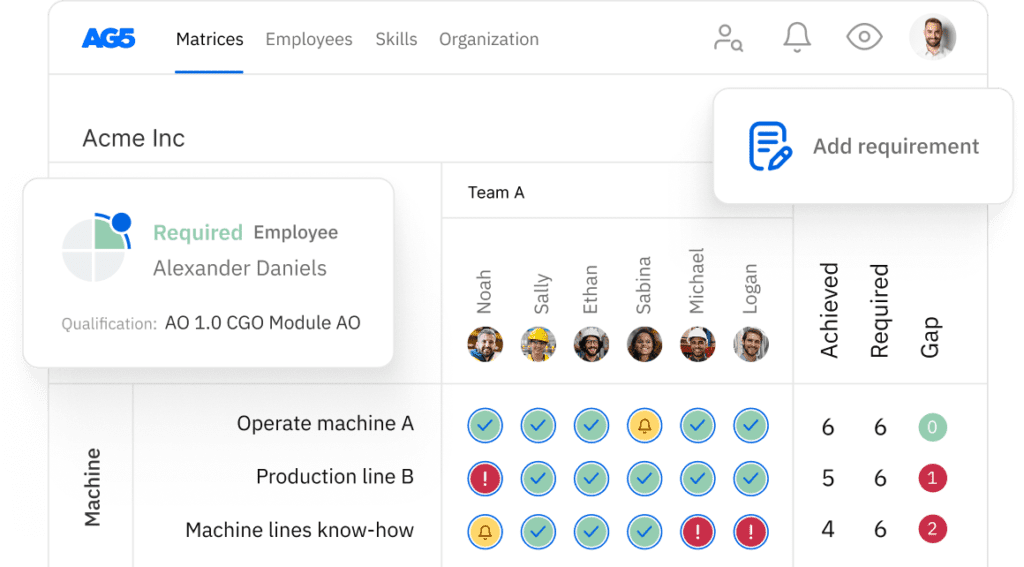Career development frameworks: Why do they matter?
A career development framework defines how employees grow across roles, levels, and competencies. In 2025, it’s essential for aligning individual ambition with business strategy.

A career development framework is a structured system that defines the skills, behaviors, and experiences required for progression across roles. It ensures clarity, equity, and alignment between employee growth and business goals.
The absence of career clarity can hinder both employee engagement and organizational performance.
Based on this research paper [1], the career development framework (CDF) acts as the scaffolding that supports structured growth, aligning individual ambitions with strategic talent needs.
For auditors and operations managers, such frameworks offer transparent role expectations and compliance with regulatory learning standards. For training coordinators, it provides a blueprint for targeted learning design.
For ICT managers, it enables digital integration across HR systems.
Key objectives of a career development framework include:
- Clarity. Articulating what skills and behaviors are expected at each level
- Equity. Offering consistent criteria across departments and demographics
- Scalability. Standardizing growth pathways to manage large or complex teams
- Motivation. Encouraging employees by making growth visible and attainable
Organizations that implement a CDF often report improved retention, stronger succession pipelines, and a marked uplift in workforce agility.

How does a career development framework support skills growth and operational goals?Copied
A career development framework links employee growth to organizational priorities by identifying critical skills, guiding learning investments, and aligning career paths with strategic objectives.
For growth to be meaningful and measurable, it must be both employee-centric and business-aligned. A robust framework serves as the bridge between these two dimensions, ensuring that individual development fuels broader performance outcomes.
For training coordinators, this means crafting learning programs that are directly tied to role expectations and future competencies.
For ICT and operations managers, it enables strategic workforce planning by forecasting talent needs and addressing capability gaps.
How a career framework drives skills and outcomes
| Area | Framework contribution | Operational impact |
|---|---|---|
| Skills mapping | Defines required competencies per role | Aligns learning to real business needs |
| Development planning | Guides employees on how to progress | Boosts engagement and ownership |
| Performance integration | Links progression to behavioral and results indicators | Drives accountability and consistent standards |
| Succession strategy | Identifies and prepares internal talent for key roles | Reduces disruption and hiring costs |
By making career expectations explicit, frameworks empower people to grow with purpose – while ensuring those investments in growth support the company’s most urgent goals.
What are the core components of an effective career framework?Copied
An effective career framework includes job families, defined levels, role descriptions, competency matrices, and progression criteria, all built around skills, behaviors, and measurable outcomes.
A career development framework must balance clarity and flexibility. For structured roles like those in operations or ICT, granularity is key, outlining exact skills needed for progression. For functions like auditing and L&D, the framework must account for evolving knowledge standards and behavioral excellence.
The following components form the backbone of a high-quality framework:
| Component | Description | Value to organization |
|---|---|---|
| Job families | Group related roles (e.g. audit, IT, ops) into categories | Creates consistency and aids comparison |
| Career levels | Define tiers (e.g. entry, intermediate, senior, expert) | Clarifies expectations at each stage |
| Role descriptions | Detail responsibilities, required skills, and outcomes per level | Supports hiring, development, and performance |
| Competency matrix | Maps technical and behavioral skills across levels | Standardizes assessments and guides training |
| Progression criteria | Specifies what is needed to move from one level to the next | Enhances fairness, transparency, and engagement |
An effective framework acts as both a talent blueprint and a strategic map, helping HR and business leaders make data-informed decisions on workforce capability and succession.
How do you build a career development framework from scratch?Copied
To build a career development framework from scratch, start with business alignment, define role structures, map competencies, and embed the framework into HR systems and culture.
Creating a framework is a structured, yet iterative process.
It requires input from multiple stakeholders – HR, department heads, learning leaders, and system owners – to ensure relevance, scalability, and sustainability.
Core phases of framework development
- Assess organizational needs
- Align career development with strategic goals
- Identify key growth areas and talent gaps
- Define role structures
- Group roles into job families and define career levels
- Ensure flexibility for future evolution
- Map competencies
- Create a matrix of required skills and behaviors per level.
- Include both technical (hard) and behavioral (soft) competencies.
Example: Competency matrix snapshot
| Level | Technical skill (e.g. Data analysis) | Behavioral skill (e.g. Collaboration) |
|---|---|---|
| Entry | Basic use of reporting tools | Participates actively in team tasks |
| Intermediate | Analyses datasets for insights | Leads small team projects |
| Senior | Designs analytic models | Coaches peers on collaborative methods |
- Establish progression criteria
- Define what’s required to move up: skills, achievements, behaviors
- Base promotions on objective standards, not tenure alone
- Embed & communicate
- Integrate into learning systems, performance reviews, and onboarding
- Train managers to use the framework in career conversations
Tip: Use pilot teams (e.g. ICT or operations) to test the framework before scaling organization-wide.
When should you update or evolve your career development framework?Copied
A career development framework should be reviewed annually and updated whenever roles, technologies, or strategic priorities shift – ensuring continued relevance and effectiveness.
Like any strategic tool, a career development framework is not static. Failing to revise your framework can lead to misalignment, outdated competencies, and disengaged employees.
Regular evaluation ensures that your career architecture reflects current business needs and market realities.
Update triggers to watch for
- Organizational restructures. New departments or merged roles require refreshed job families
- Technology upgrades. New systems (e.g., data platforms, cybersecurity tools) demand updated technical skills
- Regulatory changes. Particularly important for auditors and compliance teams where certifications evolve
- Shifts in strategy. If your business pivots (e.g., from operations to innovation-led growth), your career paths must follow
- Feedback from managers and staff. Career stagnation signals a framework that’s no longer serving development needs
Recommended review cadence
| Review type | Frequency | Focus area |
|---|---|---|
| Light review | Every 6–12 months | Skill relevancy, minor structural tweaks |
| Full framework audit | Every 2–3 years | Role redefinition, level restructuring |
Tip for training coordinators: Use performance feedback loops and learning data to identify emerging skill gaps and inform framework updates.
Do career frameworks improve retention, performance, and engagement?Copied
Yes. Career development frameworks drive retention, boost performance, and enhance engagement by clarifying growth pathways, aligning expectations, and making development actionable.
When employees understand how they can grow – and what’s expected of them – they’re more likely to stay, perform, and invest in their roles.
Career frameworks provide a shared language for success, linking aspirations to measurable outcomes.
Impact pathways
- Retention. Frameworks reduce uncertainty and turnover by showing employees a future within the organization
- Performance. Clear competencies and criteria help managers coach more effectively and conduct fairer reviews
- Engagement. Access to visible, equitable growth opportunities increases motivation and psychological safety
Performance & retention outcomes
| Organization | Intervention | Reported result |
|---|---|---|
| Leapsome client | Career pathing framework + learning goals | +29% employee satisfaction within 6 months |
| Tech company (ICT) | Skill-based levels + performance matrix | 40% drop in regrettable attrition |
| Logistics firm | Role clarity via framework | Reduced time-to-productivity by 33% |
Manager insight: Operations managers often report smoother onboarding and fewer capability mismatches when career paths are embedded into hiring and team design.
How can technology and platforms support career development frameworks?Copied
Technology enables scalable, data-driven career development by mapping skills, tracking progress, and integrating learning pathways – transforming static frameworks into dynamic ecosystems.
Modern frameworks must live in platforms, not spreadsheets.
With the right digital tools, organizations can automate competency mapping, personalize learning plans, and align development activities with business needs in real time.
Key technological enablers
- Skills taxonomy engines. Define and update skills across job families using AI
- Learning Experience Platforms (LXP). Suggest training linked to an individual’s framework level
- Performance & talent suites. Integrate career development with reviews and succession planning
- Internal talent marketplaces. Match employees to roles, gigs, or projects aligned with their growth plan
Platform capabilities table
| Tool type | Function | Benefit to users |
|---|---|---|
| Career framework software | Maps levels, competencies, and role criteria | Increases clarity and scalability |
| LXP (e.g., Degreed, EdCast) | Recommends learning content per role and level | Supports self-driven, skills-based development |
| HRIS integration | Links performance data and career growth | Enables unified talent visibility |
| Analytics dashboards | Tracks framework adoption and skill progression | Informs strategy and identifies gaps |
Tip for ICT managers: Choose platforms that are modular and API-ready to ensure seamless integration with existing HRIS and learning systems.
What are the best practices for ensuring fair and transparent career progression?Copied
To ensure fairness and transparency, organizations must define objective criteria, communicate openly, train managers, and monitor equity through data analytics.
Equity in career development is not optional, it is expected. A well-structured framework can mitigate bias, promote inclusion, and build trust across the workforce.
However, it must be implemented with rigor and intention.
Best practices checklist
- Standardized criteria. Define clear competencies and progression benchmarks across departments
- Transparent communication. Publish frameworks internally and offer guidance documents
- Manager calibration. Train people leaders to apply criteria consistently and support development plans
- Regular audits. Use DEI analytics to assess progression trends by gender, ethnicity, and tenure.
- Employee access. Provide career tools and dashboards to enable self-assessment and planning.
Illustrative practices by persona
| Persona | Best practice focus | Why it matters |
|---|---|---|
| Auditors | Role clarity and regulatory compliance in progression | Ensures fairness and audit-readiness |
| Training coordinators | Curriculum alignment with framework stages | Targets learning where it impacts most |
| ICT managers | Systems that track skill acquisition & promotions | Delivers data for workforce planning |
| Ops managers | Clear expectations and succession criteria | Drives team performance and internal mobility |
Fair career frameworks build psychological safety, foster diversity, and retain talent that might otherwise feel overlooked or disengaged.
Do leading companies use frameworks to drive learning and succession planning?Copied
Yes. Leading organizations integrate career frameworks with learning systems and succession planning to proactively develop talent, close skills gaps, and secure leadership pipelines.
Career development frameworks are increasingly central to enterprise talent strategies.
At companies like IBM, Novartis, and Schneider Electric, frameworks aren’t static charts, they’re live systems that shape development at every level.
By embedding frameworks into L&D, companies guide employees through intentional growth journeys. When tied to succession plans, they identify high-potential individuals and track readiness for leadership.
Corporate examples:
- IBM uses a skills-based framework [2] to personalize career journeys and predict leadership readiness using AI
- Novartis aligns learning modules [3] with each level of its framework, ensuring employees gain future-critical capabilities
- Schneider Electric uses its internal mobility and career system [4] to drive 85% of open roles from within
Dual benefits of framework integration
| Area | Framework contribution | Organizational Impact |
|---|---|---|
| Learning strategy | Pinpoints skill gaps and delivers relevant training | Improves learning ROI and closes capability gaps |
| Succession planning | Identifies future leaders and tracks readiness | Strengthens bench depth and business continuity |
| Engagement | Aligns growth with personal ambition | Increases retention and internal promotions |
Insight for training coordinators: When course catalogues and frameworks speak the same language, learning becomes strategic – not just administrative.
How to align career frameworks with performance reviews and learning systems?Copied
To align frameworks with performance and learning systems, embed role-specific competencies into review templates, link development goals to framework criteria, and integrate platforms for seamless data flow.
When career development is siloed from performance and learning, it becomes aspirational rather than actionable. The solution lies in integration: using the framework as a shared architecture that informs how employees are assessed, developed, and promoted.
Alignment strategies
- Integrate framework into review templates
- Align performance ratings with framework competencies per role level
- Use behavioral indicators as benchmarks for qualitative feedback
- Link learning goals to progression criteria
- Assign targeted courses and experiences that support advancement to the next career level
- Highlight role-relevant learning paths in the LMS
- Use a unified talent platform or API bridges
- Ensure your HRIS, LXP, and performance system can exchange data
- Track development plans, skill acquisition, and career movement in one view
Systems integration overview
| Component | Integration point | Value created |
|---|---|---|
| Career framework | Skills and level criteria | Foundation for consistency |
| Performance reviews | Competency evaluation fields | Transparent assessment and feedback |
| Learning system | Role-linked content & development planning | Targeted upskilling and real-time career growth |
For operations and ICT managers: Integration reduces duplication, clarifies development priorities, and allows teams to align career planning with real performance data.
FAQs Copied
-
What is a career development framework?
-
How does it benefit employees?
-
Why do organizations need a career development framework?
-
How often should a career framework be updated?
-
Can small organizations implement career frameworks?
-
What role do managers play in the framework?
-
How do technology platforms support frameworks?
-
Are career frameworks linked to performance reviews?
Sources Copied
- Change view: Table
-
APA
| # | Source title | Description | Publication | Retrieved | Source URL |
|---|---|---|---|---|---|
| 1 | Career Frameworks and Development: The Individual Perspective | Research Gate | January 31, 2025 | August 14, 2025 | https://www.researchgate.net/p.. |
| 2 | Skills first – put your plan into action | IBM | April 10, 2024 | August 15, 2025 | https://www.ibm.com/new/traini.. |
| 3 | Ethics, Risk and Compliance - Compliance Training Approach | Novartis | March 1, 2025 | August 7, 2025 | https://www.novartis.com/sites.. |
| 4 | How to augment your career story by making the most of Internal Mobility Program | Life @ Schneider | June 12, 2018 | August 21, 2025 | https://blog.se.com/life-at-sc.. |
Author Copied
Revisions Copied
Written by: Rick van Echtelt
Copy edited by: Adam Kohut

